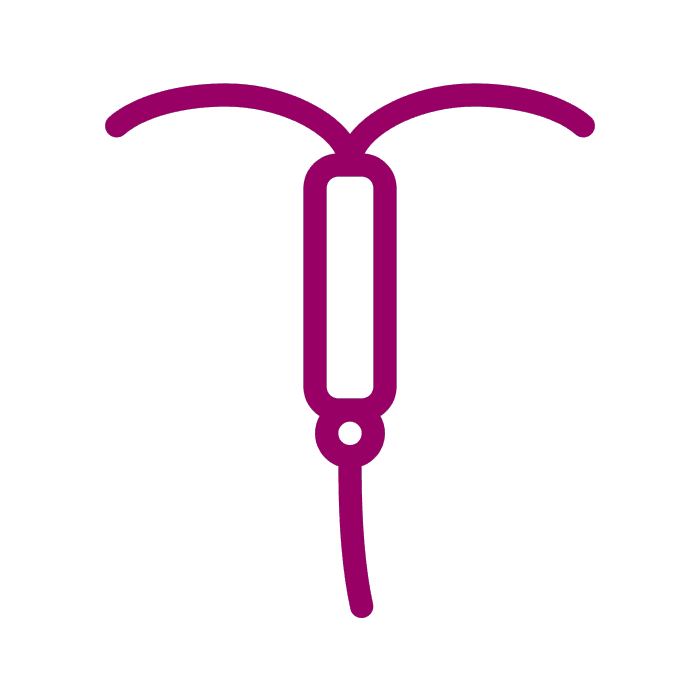
CONTRACEPTIVE IMPLANT
Hormonal Method
1 or 2 small hormone releasing silicone rods put under the skin by a healthcare provider.
99 % Effective
Details
Contraceptive implants are small flexible rods that are placed just under the skin of your upper arm by a healthcare professional. Depending on the type of implant, one or two rods are implanted. The rods steadily release the hormone progestogen into your bloodstream, preventing the release of an egg from your ovary (ovulation). This hormone also thickens the mucus in your cervix to stop the sperm from entering your uterus.
The contraceptive implant provides very effective contraception for 3 to 5 years, depending on the type used.
How to
Your trained healthcare provider will inject a local anaesthetic to numb the area on the inside of your upper arm. The implant is then inserted just under the skin. You will not need stitches. The implant then releases a steady flow of progestogen over 3 to 5 years, depending on the type of implant. You can have it removed at any time by your healthcare provider, and your natural fertility will return very quickly.
Cons
It has to be fitted and removed by a trained healthcare professional
You may feel some bruising, tenderness or swelling around the implant when it is first inserted
There may be a change in your periods – they may become irregular, lighter, heavier or longer
It does not protect you against sexually transmitted infections (STIs), such as HIV), so you may need to use condoms as well
Pros
A very effective form of contraception, with an effectiveness rate of 99.9%
It does not interrupt sex
It is suitable for women who want to avoid having to remember to take contraceptive pills or injections, and who want a long-acting, reversible contraceptive method.
It is useful for women who cannot use contraception that contains oestrogen.
First several months to a year:
Lighter bleeding and fewer days of bleeding
Periods that last longer
Irregular bleeding
Infrequent bleeding
No monthly bleeding
Side Effects
You may experience:
Changes in your monthly bleeding patterns, including:
These changes in bleeding are normal and are not harmful. If you find them bothersome, speak to your healthcare professional.
Headaches
Stomach pain
Acne (can improve or worsen)
Changes in weight
Tender breasts
Dizziness
Mood changes
Nausea
After about one year:
Lighter bleeding and fewer days of bleeding
Irregular bleeding
Infrequent bleeding
No monthly bleeding
Frequently Asked Questions
-
Contraceptive implants are small flexible rods placed just under the skin of your upper arm by a healthcare professional. Depending on the type of implant, one to two rods are inserted.
-
The implant is about the size of a thin matchstick, and people have it inserted under the skin of the inner side of the upper arm. Although one can feel it, it is not seen, except if someone is looking for it. At the site of insertion, there will be a tiny mark, but this isn’t very visible as a trained healthcare provider has inserted the implant.
-
Many women find that heavy, painful periods reduce. There can sometimes be irregular bleeding initially, but this should go after the first few months.
-
After counselling by your healthcare provider and ensuring that you are not pregnant, the implant should be inserted within seven days after the onset of menstruation, or immediately or within seven days after an abortion. If the contraceptive implant is inserted at any other time, you will need to use an additional non-hormonal (barrier) method for the following seven days. In case of questions, please consult with your healthcare provider.
-
You will receive local anaesthesia so there should be very little pain. The procedure takes only a few minutes. There might be a bit of bruising or soreness afterwards.















CONTRACEPTIVE METHODS
CONTRACEPTIVE METHODS
-

CONTRACEPTIVE INJECTION
The contraceptive injection is a shot of hormones that lasts for 1 up to 3 months.
-

CONTRACEPTIVE PATCH
A patch that sticks to the skin and releases hormones that are highly effective at stopping pregnancy.
-

CONTRACEPTIVE RING
A flexible plastic ring that is placed in the vagina by the woman and constantly releases hormones.
-

DIAPHRAGM
A diaphragm is a small dome that blocks the entrance to the cervix to stop sperm from entering the womb.
-

EMERGENCY CONTRACEPTIVES
Emergency contraceptives are hormone-based pills that are used in the event of accidental unprotected sex.
-

FEMALE CONDOM
A female condom is a sheath that is placed inside a woman’s vagina before sexual intercourse.
-

FERTILITY AWARENESS
Fertility awareness is the method of only having sex on the non-fertile days of your menstrual cycle.
-

INTRAUTERINE DEVICE
An IUD is a small, flexible, often T-shaped device wrapped in copper that is placed inside your womb by your healthcare provider.
-

INTRAUTERINE SYSTEM-IUS
An IUS is a small, flexible, T-shaped system that releases low levels of hormones and is placed inside the womb by your healthcare provider.
-

MALE CONDOM
A condom is a thin film sheath that is placed over a man’s erect penis before having sex.
-

PULL-OUT METHOD
Pulling out (also called Withdrawal Method) requires no additional hormones or devices, just impeccable timing and a lot of luck.
-

SPERMICIDES
Spermicides affect the way sperm travels in the womb making it hard for them to move freely and fertilize an egg.
-

SPONGE
A sponge blocks the entrance to the cervix and releases spermicide, both together stopping sperm from entering the womb and fertilizing an egg.
-

STERILISATION
Sterilisation is the process of completely taking away the body’s ability to reproduce through surgery or minimal invasion.
-

THE PILL
The pill is a small tablet containing hormones that must be swallowed every day, at the same time.



